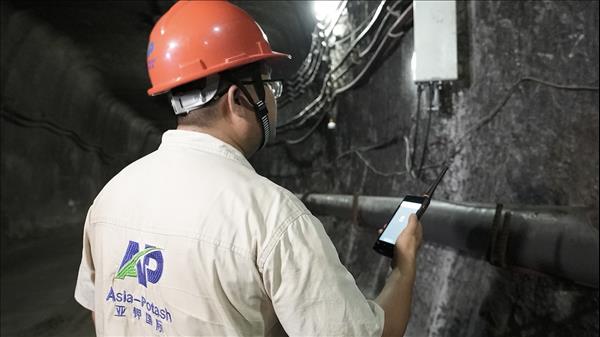(MENAFN- Asia Times) Huawei Technologies, a Shenzhen-based telecommunication equipment maker, is focusing on“5G2B” – the application of advanced broadband, Artificial Intelligence, and Big Data to business-as its main growth driver.
American sanctions cut off Huawei's access to the advanced chips that power 5G handsets, pushing the Chinese giant from the top position in the global smartphone market in early 2020 to number seven in 2021.
A major focus for Huawei is mining.
The company announced its first smart mining showcase project in Southeast Asia on December 15. It said it had implemented its information and communications technology (ICT) solution in the mining area of asia-potash international investment , a Shenzhen-listed potassic fertilizer supplier, in Laos.
The announcement came after Huawei's founder and chief executive Ren Zhengfei said in August that the company would shut down or reduce unprofitable businesses and focus more on its high-value lines in the coming few years.
“Our goal is not to generate immediate revenue but to effectively combine our digital capability with the miners' industrial knowhow,” Xu Jun, chief technology officer of Huawei's mining team, told Asia Times in an interview on Monday.
“As a business person, Mr. Ren says we will make money from new businesses at the end of the day but he does not mean immediate revenue,” Xu said.“With our current status in China, we can make money in a lot of different ways quickly and easily.”
Xu said that Ren's message was that Huawei should contribute to China's Industry 4.0 or Fourth Industrial Revolution, which refers to the use of the Internet of Things (IoT), cloud, big data and artificial intelligence technologies in industry upgrade.
He said China missed the First and Second Industrial Revolutions in the 1750s and 1870s, respectively, and was trying to catch up with the Third Industrial Revolution, or Digital Revolution, in the past few decades. He said China should not miss Industry 4.0.
Since Huawei's chief financial officer Meng Wanzhou was detained on fraud charges in Canada in December 2018, Huawei has faced several rounds of sanctions imposed by the United States.
Although Meng was allowed to return to China in September last year, Washington continued to step up its sanctions against Huawei. In recent years, the company has been facing rising difficulties in purchasing high-end chips and accessing the western markets.
In August this year, the company said its net profit fell by 52% to 15.1 billion yuan (US$2.2 billion) in the first half of 2022 from a year ago while its net margin dropped from 9.8% to 5%.

Huawei's founder and chief executive Ren Zhengfei Photo: CCTV
Ren said in an internal memo that the company should not focus only on concepts but achieve real technological breakthroughs in the coming two years.
At present, the company's six main businesses are ICT infrastructure, terminal devices, digital power, cloud, intelligent automotive solutions, and its fabless semiconductor business Hisilicon.
Xu said Huawei had started thinking about how to leverage its digital capability in other industries in 2019. He said Ren decided to focus on the mining sector after he visited a few mines in China in 2020.
“It's the wisdom of our founder to choose the mining sector,” said Xu.
He added that Huawei's technologies and equipment could be used to help miners ensure safety and avoid production disruptions.
Initially, Huawei applied its smart mining expertise to China's coal mines. In February 2021, it opened an intelligent mining innovation lab in Taiyuan, Shanxi province, exploring new uses of ICT technologies including wireless industrial control networks, industrial optical ring networks, and cloud computing, in coal mines.
Ren said the company would use its digital technologies in hundreds of coal mines, iron and steel plants, and ports in the coming few years.
Huawei has also built 5G networks to provide remote control and monitoring services to miners in China, but relied on 4G networks in other regions such as South Africa and Latin America.
Over the past year, a digital platform called mineharmony , jointly developed by Huawei and China Energy Investment Corp, has been deployed in more than 3,300 sets of equipment in 13 coal mines and one coal washing plant of Shendong Coal Group in China.
Two months ago, Huawei introduced its ICT solution into Asia-Potash's mining area in Khammouane, 350 kilometers away from Vientiane, Laos' capital. Asia-Potash currently has more than 3,000 employees in the area.
Last week, Huawei officially announced this project and said that a miner made the first WeChat video call 300 meters underground to report the real-time situation there to Asia-Potash's headquarters in China. It built both wireless and wired private networks above and below the ground to suit different needs.
Xu said although Asia-Potash was a Chinese firm, Huawei still had to go through a competitive tendering procedure to win this project. He said Huawei was accumulating experience in smart mining and would use the experience in other industries such as the refinery and iron and steel sectors.
“Mining is a new thing for us, and we need to make new friends to be part of the ecosystem,” Xu said.“We want to close the gap between our IT people and industry folks as sometimes we don't understand each other well.”
“A deep integration between the IT and industrial sectors is definitely a challenge,” he said.“When we talk about artificial intelligence, miners have no idea what we are talking about. We have to learn and try to use their language.”
Xu joined Huawei's mining team 18 months ago and visited some mines to learn about the industry. Before this, he worked for Huawei's cloud division in Latin America.
read: blocked in the west, huawei eyes emerging markets
Follow Jeff Pao on Twitter at @jeffpao3





















Comments
No comment